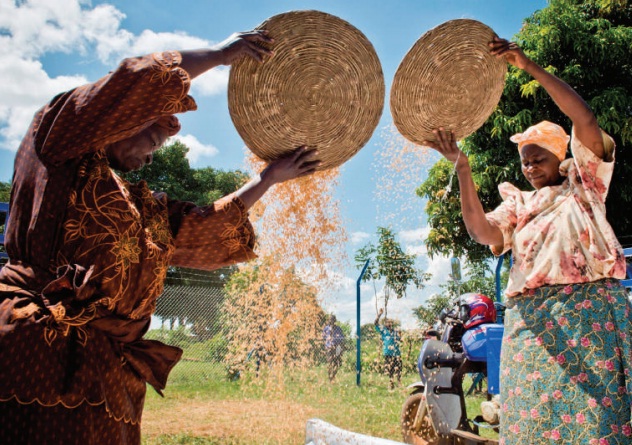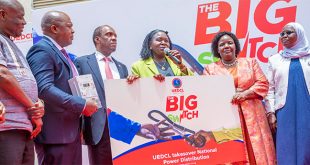
Successful `Zero Food Loss’ programme run by WFP nears target of 240,000 smallholder farmers
What do you do if you run a school in a poor rural area and have to feed 800 pupils? That is the challenge the parents and teachers of Lumuli Primary School in Butagaya sub-County, Jinja district, in eastern Uganda, faced.
They decided to use the only resource they had – maize they grew on their small patches of farmland. Each parent would bring 4kgs per pupil to the school every term. That would be 3,200kgs or several plates of energy-giving maize meal porridge per day per pupil. But soon they were getting armies of uninvited guests in the form of rats and weevils who consumed up to 40% of the maize collected.
“If we kept 1,200kg of maize, children would only use about 800kg and 400kg would go to waste after being eaten by rats and weevils,” recalls Telsiphole Sibomana, a teacher.
Unknown to the school administrators, the UN agency; World Food Programme (WFP), had also been battling the same challenge. The WFP had done research that showed that at least 1.3 billion tonnes or one-third of food produced globally is lost or wasted every year due to poor handling right from the garden during harvest time.
Another study done in 2011 by the UN’S Food and Agriculture Organisation showed that, in just a few weeks after harvest, subSaharan Africa alone loses 20 million metric tonnes of food every year valued at over US$4 billion. That amount of food lost in one year, exceeds the value of total food aid received in Sub-Saharan Africa over the last 10 years, and is almost equal to the annual value of cereal imports to Sub-Saharan Africa. In addition, such losses are estimated to be equivalent to the annual caloric requirement of 48 million people.
FAO also estimates that up to 47% of $940 billion needed to eradicate hunger in SubSaharan Africa by 2050 will be required in the post-harvest sector.
Based on these reasons, agriculture experts agreed that investing in post-harvest loss reduction is a quick impact intervention that reduces food losses, increases food availability, reduces poverty, and improves nutrition.
Training communities
Richard Mbowa, 37, a local in Buwala village in the same Butagaya sub-County area was the kind of smallholder farmer that WFP had in mind. Mbowa had been growing maize and other crops on his eight acre field for most of his adult life, but he had nothing to show for his back-breaking efforts.
Although Mbowa knew it was smarter to wait for prices to improve, he could not keep his harvest as he had no means to fight off rodents, weevils, and other vermin determined to destroy it.He estimated that he was losing about 30% of his harvest to vermin and wastage. Sometime,two years ago,WFP field staff showed up in Butagaya and offered to train the locals in how to avoid harvest loss. Mbowa and 20 of his friends, including teachers from Lumuli Primary School received training in how to properly handle the harvest on their farms, how to transport it, dry it, and store it.
At the centre of the training was the introduction of a new technology; a hermetic or airtight storage silo. The silo protects stored grain by stopping contact between the dry grains stored in the container and the oxygen and water in the atmosphere outside. In this way, no living organism – be it a rat or weevils, can enter the silo and survive.
Mbowa recalls that he had doubts that this simple technology would work. But when WFP gave him a 1000kg cylindrical aluminum metal silo which looks like a big-sized milk can, he decided to try it out. Lumuli Primary School was also given a silo, of 1,250kg capacity.They all have never looked back.
Mbowa now keeps some of his harvest in the silo and sells it eight months later during the lean period.
“When you store your maize at a time when a kilogramme is going for Shs 400 and sell five months later at a profit, the difference that makes is quite big for me,” he says.
He says his earnings have gone up and he has managed to build a four-bedroom house for his family within two years.
His and many other similar stories from smallholder farmers all over Uganda attracted a delegation of WFP representatives from 18 countries (representing WFP’s six regional bureaus around the world) to visit Uganda and learn about the successful collaboration between the smallholder farmers, the private sector, and WFP on this project. Mbowa showed them how the modern silo initiative has changed his life in less than two years.
“I was surprised to find exactly what I had put in the silo,” Mbowa told a group of over 50 WFP delegates who visited his home onMay 18. He says, last season, he kept about 1000kg of his maize in his silo and sold it eight months later. Over that period, the price of maize rose from Shs 400 per kilo to Shs1000; meaning he earned Shs1 million (Approx. US$300), instead of Shs400,000 (Approx. US$118) from his harvest. That money is still very little, but it makes a huge difference in an economy where the average income per year per person is about US$718, according to 2015 World Bank figures. Mbowa plants and harvests from two seasons each year.
 The Independent Uganda: You get the Truth we Pay the Price
The Independent Uganda: You get the Truth we Pay the Price




Wonderful article. bt how can a farmer in masaka or sembabule get access to these silos
Actually I appreciate for that great information that you give to us as farmers of butagaya, am malusu Isaac a student nurse of international institute of health science jinja and a resident of lubani butagaya kagoma county. Me my concern is all about how can I get helped in good methods of farming and good quality seeds that can mature earlier because my problem is tuition and I always want to plant brides that I can harvest earlier. Any help is highly appreciated.
Where can we sign up for the for training sessions offered by Action for relief and development headed by Mr. Joseph Kyegombe?.
Please help, I am a new farmer who is planning on doing large scale.